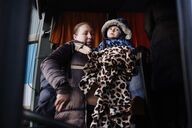Refine search
No keyword found to refine search
keywords EN
Places
Names
3 documents found
| 1 |
Documents per page :

Influx of refugees on the Polish-Ukrainian border following the Russian army's invasion
Jan Schmidt-Whitley/Le Pictorium
LePictorium_0260600.jpg
In Mlymy, a shopping centre hosts more than 6,000 refugees who left Ukraine following the invasion by the Russian army. The Shehyni border crossing in Ukraine is for many refugees the last stop before returning to Poland via the town of Medika. Tens of thousands of refugees sometimes have to wait for long hours before they can leave the Ukrainian territory. Once they cross the border, Polish and international volunteers take charge of them. Most of them will spend a night or two in one of the improvised reception centres that can accommodate up to 6,000 people. Then the refugees board buses or trains that take them to their final destination.

Influx of refugees on the Polish-Ukrainian border following the Russian army's invasion
Jan Schmidt-Whitley/Le Pictorium
LePictorium_0260601.jpg
In Mlymy, a woman and her son board a bus to Israel set up by Jewish organisations. The Shehyni border crossing in Ukraine is for many refugees the last stop before returning to Poland via the town of Medika. Tens of thousands of refugees sometimes have to wait for long hours before they can leave the Ukrainian territory. Once they cross the border, Polish and international volunteers take charge of them. Most of them will spend a night or two in one of the improvised reception centres that can accommodate up to 6,000 people. Then the refugees board buses or trains that take them to their final destination.

Influx of refugees on the Polish-Ukrainian border following the Russian army's invasion
Jan Schmidt-Whitley/Le Pictorium
LePictorium_0260602.jpg
In Mlymy, a woman boards a bus to Israel set up by Jewish organisations. The Shehyni border crossing in Ukraine is for many refugees the last stop before returning to Poland via the town of Medika. Tens of thousands of refugees sometimes have to wait for long hours before they can leave the Ukrainian territory. Once they cross the border, Polish and international volunteers take charge of them. Most of them will spend a night or two in one of the improvised reception centres that can accommodate up to 6,000 people. Then the refugees board buses or trains that take them to their final destination.
